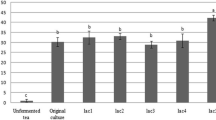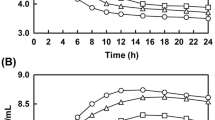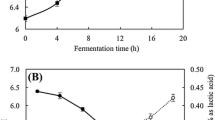Abstract
The purpose of this study is to establish the best condition and microorganism for preparation of fermented ginseng including rich compound K. When raw ginseng parts were incubated with various microorganisms, there was an increase in compound K at 5 days in all samples fermented by Lactobacillus brevis (L. brevis) and Lactobacillus plantarum, isolated from kimchi. Especially, ginseng fine roots fermented with L. brevis (FR-B) included higher levels of compound K, total phenolic compounds, and antioxidant activities compared with other products. Conclusionally, these results indicate that the optimum condition for providing rich compound K product in fermented ginseng is ginseng fine roots are fermented with L. brevis for 5 days. Additionally, with FR-B there was greater improvement in physiochemical properties than with other products. Such information may be helpful for the manufacture of fermented ginseng including rich compound K as well as for understanding the biological features of fermented ginseng.


Similar content being viewed by others
Abbreviations
- FR-B:
-
Fine root fermented with L. brevis
- FR-P:
-
Fine root fermented with L. plantarum
- MR-B:
-
Main root fermented with L. brevis
- MR-P:
-
Main root fermented with L. plantarum
- RB-B:
-
Root bark fermented with L. brevis
- RB-P:
-
Root bark fermented with L. plantarum
References
Akao T, Kanaoka M, Kobashi K. Appearance of compound K, a major metabolite of ginsenoside Rb1 by intestinal bacteria, in rat plasma after oral administration–measurement of compound K by enzyme immunoassay. Biol. Pharm. Bull. 21: 245–249 (1998)
Bae EA, Hyun YJ, Choo MK, Oh JK, Ryu JH, Kim DH. Protective effect of fermented red ginseng on a transient focal ischemic rats. Arch. Pharm. Res. 27: 1136–1140 (2004)
Bai Y, Ganzle MG. Conversion of ginsenosides by Lactobacillus plantarum studied by liquid chromatography coupled to quadrupole trap mass spectrometry. Food Res. Int. 76: 709–718 (2015)
Birasuren B, Kim NY, Jeon HL, Kim MR. Evaluation of the Antioxidant Capacity and Phenolic Content of Agriophyllum pungens Seed Extracts from Mongolia. Prev. Nutr. Food Sci. 18: 188–195 (2013)
Dai D, Zhang CF, Williams S, Yuan CS, Wang CZ. Ginseng on Cancer: Potential Role in Modulating Inflammation-Mediated Angiogenesis. Am. J. Chin. Med. 45: 13–22 (2017)
Hofseth LJ, Wargovich MJ. Inflammation, cancer, and targets of ginseng. J. Nutr. 137: 183S–185S (2007)
Kim A, Im M, Hwang YH, Yang HJ, Ma JY. Jaeumganghwa-Tang Induces Apoptosis via the Mitochondrial Pathway and Lactobacillus Fermentation Enhances Its Anti-Cancer Activity in HT1080 Human Fibrosarcoma Cells. PLoS One 10: e0127898 (2015)
Kim DG, Lee MR, Yoo JM, Park KI, Ma JY. Fermented herbal formula KIOM-MA-128 protects against acute colitis induced by dextran sodium sulfate in mice. BMC Complement. Altern. Med. 17: 354 (2017)
Lee MH, Lee YC, Kim SS, Hong HD, Kim KT. Quality and antioxidant activity of ginseng seed processed by fermentation strains. J. Ginseng Res. 39: 178–182 (2015)
Li Z, Ahn HJ, Kim NY, Lee YN, Ji GE. Korean Ginseng Berry Fermented by Mycotoxin Non-producing Aspergillus niger and Aspergillus oryzae: Ginsenoside Analyses and Anti-proliferative Activities. Biol. Pharm. Bull. 39: 1461–1467 (2016)
Liu L, Zhang R, Deng Y, Zhang Y, Xiao J, Huang F, Wen W, Zhang M. Fermentation and complex enzyme hydrolysis enhance total phenolics and antioxidant activity of aqueous solution from rice bran pretreated by steaming with alpha-amylase. Food Chem. 221: 636–643 (2017)
Odani T, Tanizawa H, Takino Y. Studies on the absorption, distribution, excretion and metabolism of ginseng saponins. IV. Decomposition of ginsenoside-Rg1 and -Rb1 in the digestive tract of rats. Chem. Pharm. Bull. (Tokyo) 31: 3691–3697 (1983)
Oh J, Kim JS. Compound K derived from ginseng: neuroprotection and cognitive improvement. Food Funct. 7: 4506–4515 (2016)
Oh JY, Kim YJ, Jang MG, Joo SC, Kwon WS, Kim SY, Jung SK, Yang DC. Investigation of ginsenosides in different tissues after elicitor treatment in Panax ginseng. J. Ginseng Res. 38: 270–277 (2014)
Park B, Hwang H, Lee J, Sohn SO, Lee SH, Jung MY, Lim HI, Park HW, Lee JH. Evaluation of ginsenoside bioconversion of lactic acid bacteria isolated from kimchi. J. Ginseng Res. 41: 524–530 (2017)
Park ES, Lee KP, Jung SH, Lee DY, Won KJ, Yun YP, Kim B. Compound K, an intestinal metabolite of ginsenosides, inhibits PDGF-BB-induced VSMC proliferation and migration through G1 arrest and attenuates neointimal hyperplasia after arterial injury. Atherosclerosis 228: 53–60 (2013)
Park HR, Lee H, Park H, Cho WK, Ma JY. Fermented Sipjeondaebo-tang Alleviates Memory Deficits and Loss of Hippocampal Neurogenesis in Scopolamine-induced Amnesia in Mice. Sci. Rep. 6: 22405 (2016)
Park KB, Oh SH. Cloning, sequencing and expression of a novel glutamate decarboxylase gene from a newly isolated lactic acid bacterium, Lactobacillus brevis OPK-3. Bioresour. Technol. 98: 312–319 (2007)
Shibata S. Chemistry and cancer preventing activities of ginseng saponins and some related triterpenoid compounds. J. Korean Med. Sci. 16 Suppl: S28–S37 (2001)
Yin J, Zhang H, Ye J. Traditional chinese medicine in treatment of metabolic syndrome. Endocr. Metab. Immune Disord. Drug Targets 8: 99-111 (2008)
Yoo JM, Sok DE, Kim MR. Anti-allergic action of aged black garlic extract in RBL-2H3 cells and passive cutaneous anaphylaxis reaction in mice. J. Med. Food 17: 92–102 (2014)
Yoo JM, Yang JH, Yang HJ, Cho WK, Ma JY. Inhibitory effect of fermented Arctium lappa fruit extract on the IgE-mediated allergic response in RBL2H3 cells. Int. J. Mol. Med. 37: 501–508 (2016)
Acknowledgements
This work was funded by the Basic Science Research Program through the National Research Foundation of Korea (NRF) funded by the Ministry of Education (Grant Number 2017R1D1A3B03027867).
Author information
Authors and Affiliations
Corresponding author
Ethics declarations
Conflicts of interest
The authors declare no conflict of interest.
Human and animal rights
This article does not contain any studies performed by any of the authors with human participants or animals.
Electronic supplementary material
Below is the link to the electronic supplementary material.
Rights and permissions
About this article
Cite this article
Yoo, JM., Lee, J.Y., Lee, Y.G. et al. Enhanced production of compound K in fermented ginseng extracts by Lactobacillus brevis. Food Sci Biotechnol 28, 823–829 (2019). https://doi.org/10.1007/s10068-018-0504-0
Received:
Revised:
Accepted:
Published:
Issue Date:
DOI: https://doi.org/10.1007/s10068-018-0504-0




